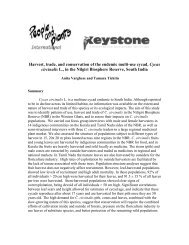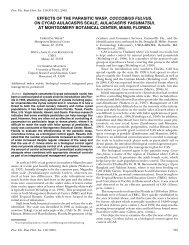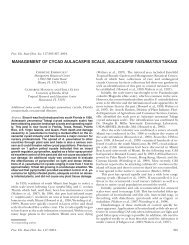Glossary of terms used in cycad systematics - Cycad Specialist Group
Glossary of terms used in cycad systematics - Cycad Specialist Group
Glossary of terms used in cycad systematics - Cycad Specialist Group
You also want an ePaper? Increase the reach of your titles
YUMPU automatically turns print PDFs into web optimized ePapers that Google loves.
Walters & Osborne – <strong>Cycad</strong> Classification: Concepts & Recommendations, Appendix 2 15<br />
obtuse. Blunt or rounded at the apex.<br />
omnel. Kernel <strong>of</strong> an omnule; a ‘cleaned <strong>cycad</strong> seed’ (Grobbelaar, 2002).<br />
omnule. Collective term for mature <strong>cycad</strong> seeds and fully-expanded unfertilised ovules that are<br />
externally <strong>in</strong>dist<strong>in</strong>guishable; ‘<strong>cycad</strong> seed’ (Grobbelaar, 2002).<br />
ontogeny. Developmental cycle or ‘life-history’ <strong>of</strong> an <strong>in</strong>dividual from its <strong>in</strong>ception until its sexual<br />
maturity.<br />
opere citado, op. cit. In reference to a publication already cited. This phrase is no longer <strong>used</strong> <strong>in</strong> modern<br />
scientific writ<strong>in</strong>g.<br />
order. Taxonomic rank below division or class but above family.<br />
orthostichy, plural orthostichies. Row created by <strong>in</strong>tersection <strong>of</strong> contact parastichies. Sporophylls <strong>in</strong><br />
Ceratozamia and Zamia cones show well-def<strong>in</strong>ed orthostichies <strong>in</strong> a near-vertical arrangement.<br />
OTU. Operational Taxonomic Unit. Any convenient taxonomic unit <strong>used</strong> <strong>in</strong> cladistics and phenetics.<br />
outgroup. In cladistics, an organism or group, closely related to, but not <strong>in</strong>cluded with<strong>in</strong> the group under<br />
analysis, and <strong>used</strong> for comparative purposes with respect to character polarity determ<strong>in</strong>ation. See also<br />
sister group.<br />
ovate. Of a two-dimensional structure that is egg-shaped <strong>in</strong> outl<strong>in</strong>e but broadest below the middle. See<br />
also elliptic, ovate.<br />
ovoid. Of a three-dimensional structure that is ovate <strong>in</strong> longitud<strong>in</strong>al section. See also obovoid.<br />
ovulate cone/strobilus. Female cone; megasporangiate strobilus.<br />
ovule. Female reproductive structure; <strong>in</strong> seed plants compriz<strong>in</strong>g a megaspore, or megaspore-derived<br />
tissue, one or more <strong>in</strong>teguments and an attachment stalk (funiculus).<br />
pachycaulous. Thick-stemmed and columnar but without any substantial secondary wood, as for the<br />
stems <strong>of</strong> arborescent <strong>cycad</strong>s.<br />
paleoendemic, palaeoendemic. Referr<strong>in</strong>g to a taxon that is a geographical remnant <strong>of</strong> a taxon formerly<br />
<strong>of</strong> much wider geographical distribution.<br />
paleontology, palaeontology. Study <strong>of</strong> organisms from former geological periods, typically fossilized<br />
plants or animals or their parts.<br />
palynology. Study <strong>of</strong> all aspects <strong>of</strong> pollen from extant and ext<strong>in</strong>ct plants.<br />
papyraceous. Papery <strong>in</strong> texture. See also chartaceous, membranous.<br />
paraphyletic. Of an artificial group compris<strong>in</strong>g a s<strong>in</strong>gle ancestor and some, but not all, <strong>of</strong> its<br />
descendants. See also monophyletic, polyphyletic.<br />
parastichy, plural parastichies. Spiral arrangement <strong>of</strong> leaves on an axis (or sporophylls <strong>in</strong> a cone).<br />
Encephalartos, Lepidozamia and Macrozamia cones show well-def<strong>in</strong>ed clockwise and anticlockwise<br />
parastichies. See also orthostichy.






